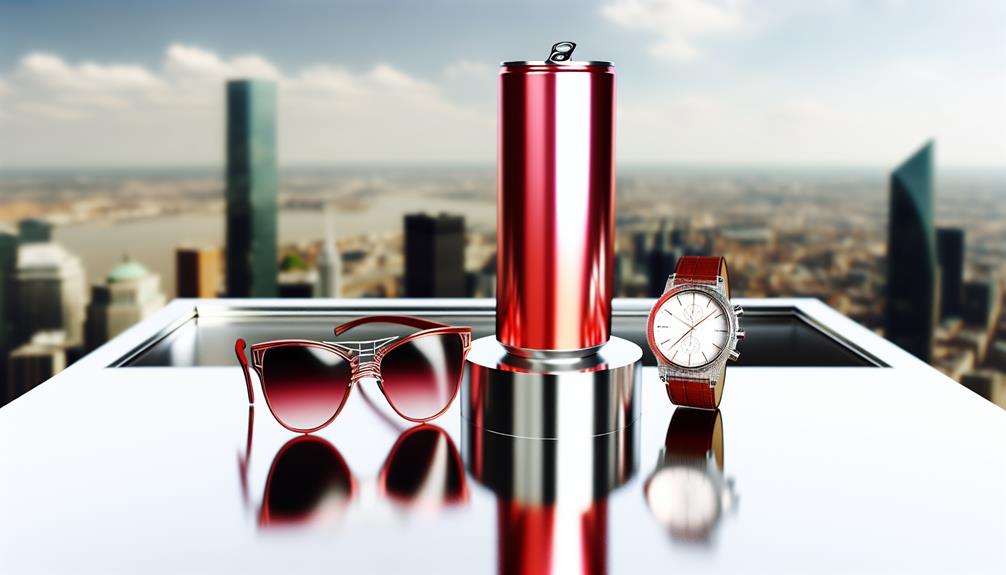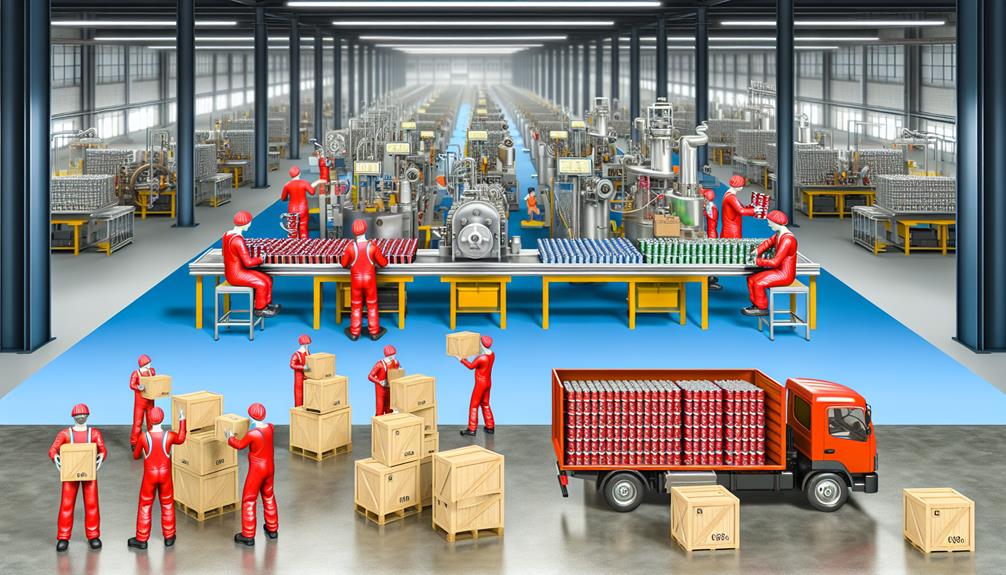You might've noticed that Red Bull comes with a higher price tag than other energy drinks on the market, and it raises an interesting question about what drives that cost. It's not just the unique marketing strategies or the premium ingredients that set it apart; there's a complex interplay of brand positioning and consumer demand at work. While it's easy to dismiss the price as mere brand power, exploring the underlying factors reveals much more. So, what exactly contributes to the perception of value that justifies this expense?
Unique Marketing Strategies
Red Bull's marketing strategies are often hailed as some of the most innovative in the beverage industry. You can't overlook how they've transformed traditional advertising into a dynamic blend of influencer partnerships and event sponsorships that resonate with their target audience. By leveraging influencer partnerships, Red Bull effectively taps into the credibility and reach of popular figures within extreme sports and lifestyle sectors. This approach not only amplifies brand visibility but also cultivates a community that associates Red Bull with high-energy activities.
In data-driven terms, research shows that consumers are 50% more likely to purchase products endorsed by influencers they follow, which directly correlates to Red Bull's rising market share. Their strategic use of influencers creates a relatable brand narrative that captivates younger demographics.
Event sponsorships further solidify Red Bull's market presence. The brand's involvement in high-profile events like the Red Bull Air Race and Red Bull Crashed Ice not only enhances brand recognition but also reinforces its association with adrenaline-pumping experiences. Analysis indicates that sponsoring events generates an average return on investment of 4:1 for brands, showcasing the financial viability of such strategies.
Premium Ingredients
When it comes to energy drinks, the quality of ingredients can markedly influence consumer choices and brand loyalty. Red Bull stands out not just for its marketing but also for its commitment to premium ingredients. This focus on quality is apparent in their ingredient sourcing and quality assurance processes, which justify the higher price point compared to other energy drinks.
Here are three key aspects of Red Bull's ingredient strategy:
- Natural Ingredients: Red Bull emphasizes the use of natural flavors and colors, distinguishing itself from competitors that rely on synthetic additives. This aligns with consumer preferences for healthier options.
- Proprietary Formula: The unique blend of caffeine, taurine, B-vitamins, and sugar is carefully formulated for peak performance. This proprietary approach means you're not just buying a drink; you're investing in a scientifically crafted product.
- Rigorous Quality Assurance: Red Bull employs stringent quality assurance protocols during production. This guarantees that every can meets high standards, thereby minimizing the risk of contaminants and inconsistencies.
Brand Positioning

The premium ingredient strategy not only enhances product quality but also plays a crucial role in Red Bull's brand positioning. By prioritizing high-quality components, Red Bull establishes itself as a leader in the energy drink market. This strategy directly influences brand perception, as consumers associate premium ingredients with superior performance and efficacy. You're not just buying a drink; you're investing in a lifestyle that promises energy and liveliness.
Data shows that consumers are willing to pay a premium for products they perceive as high-quality. In Red Bull's case, this perception translates into robust consumer loyalty. When you choose Red Bull, you're aligning yourself with a brand that champions a high-octane lifestyle, which is particularly appealing to active individuals and professionals alike. The brand's consistent marketing efforts further reinforce this image, showcasing athletes and high-energy events that resonate with their target audience.
Moreover, Red Bull's unique branding strategy encompasses not just the product but the overall experience. By sponsoring extreme sports and cultural events, Red Bull cultivates an image of excitement and innovation. This creates a community around the brand, fostering deeper emotional ties that enhance consumer loyalty.
Market Demand
Recognizing the growing trend in health consciousness among consumers, the market demand for energy drinks like Red Bull has seen a significant uptick. This increase is primarily driven by shifts in consumer behavior where individuals seek quick energy boosts for their demanding lifestyles. Yet, amidst this growth, you might wonder how price sensitivity plays a role.
Here are three key factors influencing market demand for Red Bull:
- Health and Wellness Trends: With more people prioritizing health, energy drinks that promise functional benefits attract consumers looking for alternatives to traditional caffeinated beverages.
- Target Demographics: Red Bull effectively targets active, on-the-go individuals, particularly millennials and Gen Z. These groups are less price-sensitive than older generations, often valuing brand reputation and perceived quality over cost.
- Cultural Influence: The brand's strong association with extreme sports and high-energy events fosters a lifestyle appeal, enhancing demand among adventure-seeking consumers who are willing to pay a premium.
As you analyze the market landscape, it's clear that the interplay between consumer behavior and price sensitivity is vital. While many consumers are willing to spend more for a trusted brand like Red Bull, a shift in economic conditions could alter this dynamic. Hence, understanding these factors is key for anyone looking to navigate the energy drink market strategically.
Production and Distribution Costs

How do production and distribution costs impact the pricing strategy for Red Bull? To understand this, you need to take into account both the supply chain and manufacturing efficiency. Red Bull's production involves high-quality ingredients and specialized processes, which contribute greatly to overall costs. For instance, sourcing premium caffeine and taurine can increase raw material expenses compared to competitors.
Moreover, Red Bull emphasizes manufacturing efficiency. By investing in state-of-the-art production facilities, the company can streamline operations, reduce waste, and maintain consistent product quality. This efficiency, however, comes with substantial upfront investment, which is reflected in the retail price.
Distribution costs also play an important role. Red Bull's global presence necessitates a robust logistics system. The company uses a network of distributors to guarantee products reach various markets efficiently. This supply chain management guarantees that retailers receive fresh stock, but also incurs transportation and warehousing expenses. The company often prioritizes speed and reliability, which can drive costs higher.
Ultimately, these production and distribution factors are woven into Red Bull's pricing strategy. By aligning their premium product image with higher costs, they create a perception of value that appeals to consumers willing to pay for quality. Consequently, when you purchase a can of Red Bull, you're not just buying an energy drink; you're investing in a product that reflects the complexities of its production and distribution processes.
Frequently Asked Questions
How Does Red Bull's Price Compare to Other Energy Drinks?
When you compare Red Bull's price to other energy drinks, you'll notice its market positioning reflects premium branding. This strategy fosters brand loyalty, allowing it to maintain higher prices despite competitors offering cheaper alternatives.
What Is the History Behind Red Bull's Creation?
Red Bull's rise reflects a remarkable marketing strategy, transforming an energy drink concept into a global phenomenon. Founded in 1984, it tapped into youthful energy, cleverly crafting a brand that's synonymous with vigor and adventure.
Are There Any Health Risks Associated With Drinking Red Bull?
When considering health risks, you should note Red Bull's caffeine content and sugar alternatives. Its energy boost can affect hydration levels and consumer habits, potentially leading to increased heart rate and anxiety in sensitive individuals.
Does Red Bull Offer Any Discounts or Promotions?
Red Bull does offer discounts through loyalty programs and occasionally runs promotional events. Analyzing their marketing strategy reveals they leverage these tactics to enhance customer engagement while maintaining their premium brand image.
What Are the Environmental Impacts of Red Bull's Production?
When considering the environmental impacts of Red Bull's production, you'll find that their sustainability practices aim to reduce carbon footprint, yet challenges remain, including energy consumption and resource use, which necessitate ongoing improvements for better ecological balance.
Conclusion
To sum up, Red Bull's premium pricing isn't just a coincidence; it's a strategic blend of high-quality ingredients and innovative marketing. When you sip a can, you're not just consuming an energy drink—you're investing in a brand that's synonymous with performance and lifestyle. This unique positioning, combined with market demand and elevated production costs, creates a powerful perception of value. Ultimately, you're paying for more than an energy boost; you're buying into a culture of excellence and vigor.